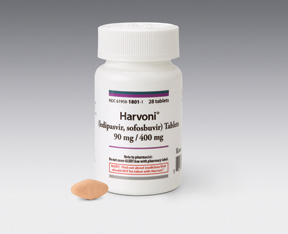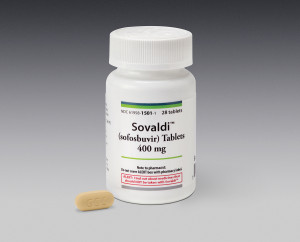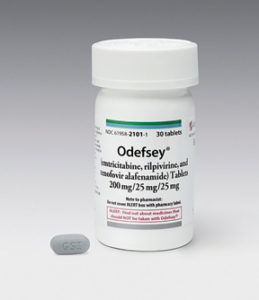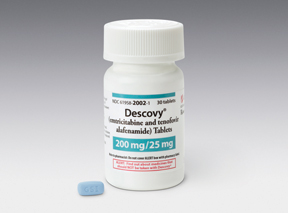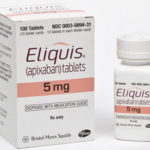Gilead: The Best (Two) Years Of Our Lives
Sovaldi and Harvoni have transformed Gilead – but what is next now that both have likely passed their peak?
Gilead Sciences Inc.
333 Lakeside Drive
Foster City, CA 94404
Telephone: 650-574-3000
Website: gilead.com
Best-Selling Rx Products
| PRODUCT | 2015 SALES | 2014 SALES |
|---|---|---|
|
Harvoni |
$13,864 | $2,127 |
|
Sovaldi |
$5,276 | $10,283 |
|
Truvada |
$3,459 | $3,340 |
| Atripla | $3,134 | $3,470 |
| Stribild | $1,825 | $1,197 |
| Complera/Eviplera | $1,427 | $1,228 |
| Viread | $1,108 | $1,058 |
| Letairis | $700 | $595 |
|
Ranexa |
$588 | $510 |
All sales are in millions of dollars.
Financial Performance
| 2015 | 2014 | |
|---|---|---|
| Revenue |
$32,639 |
$24,890 |
| Net income |
$18,108 |
$12,101 |
| Diluted EPS |
$11.91 |
$7.35 |
| R&D expense |
$3,014 |
$2,854 |
| 1H16 | 1H15 | |
|---|---|---|
| Revenue |
$15,332 |
$15,531 |
| Net income |
$7,063 |
$8,825 |
| Diluted EPS |
$5.11 |
$5.68 |
| R&D expense |
$2,749 |
$1,514 |
In millions of dollars, except EPS
Never have two drugs transformed the finances of a pharma company so quickly as Sovaldi and Harvoni have done for Gilead Sciences. In 2013, Gilead generated $11.2 billion in revenue and just over $3 billion in net income; just two years later, the company’s revenue had nearly tripled and its net income was six times greater. Two drugs that each generate more than $10 billion in their first year on the market in consecutive years can do that for a company.
Unlike most mega-blockbusters, though, Sovaldi and Harvoni both likely passed peak sales in their first years too. So the two-year ride of spectacular growth is likely over. Acknowledging as much, Gilead’s leaders spent $10 billion on stock buybacks and $1.9 billion on a cash dividend to shareholders during the course of 2015, and another $9 billion on stock buybacks in the first half of 2016. Though they might not be saying so out loud, the company’s management seems to be settling in for the long haul of slower growth, assisted by a number of antivirals at the top of the pipeline and perhaps – with nearly $25 billion in cash sitting in the bank even after all the buybacks – a major acquisition or two.
“2015 marked another extraordinary year for Gilead,” wrote Executive Chairman John C. Martin, Ph.D., and new CEO John F. Milligan, Ph.D., in their end-of-year letter to the company’s shareholders. “While the company’s portfolio has grown to 21 products and the pipeline continues to be robust, there is much more to accomplish and many significant opportunities to bring new medicines to patients around the world.”
Gilead’s top-line revenue in 2015 was $32.64 billion, an improvement of 31.1 percent compared with 2014. Net income was up 49.6 percent to $18.11 billion, and earnings per share rose by $4.56 to $11.91. This impressive leap, a year after the company had already doubled its revenue, came due largely to Harvoni’s record-breaking first year on the market, with an assist from Gilead’s growing portfolio of HIV products. With Harvoni sales falling off, though, the Gilead phenomenon appears to be finding its level in the first half of 2016. The company’s top-line revenue for the half actually declined by 1.2 percent to $15.33 billion, with net income dropping 20 percent to $7.06 billion and earnings per share down 57 cents to $5.11.
New Chairman, CEO
In January, Gilead announced that Chairman and CEO John C. Martin, Ph.D., would assume the role of executive chairman of the company and that John F. Milligan, Ph.D., previously president and chief operating officer, would be promoted to CEO and appointed to the company’s Board of Directors as of March 10.
John Martin joined Gilead in 1990 and was appointed CEO in 1996 and chairman of the board in 2008. John Milligan also joined Gilead in 1990 and was appointed chief operating officer in 2007 and president in 2008.
“John Martin has led Gilead as CEO for the past 20 years, and under his stewardship, the company has developed and delivered therapeutic advancements to millions of people around the world,” says John Cogan, Ph.D., Gilead’s lead independent director. “His legacy is clear – and the vision he has set will continue with his contributions as executive chairman.”
Prior to joining Gilead, Dr. Martin held several leadership positions at Bristol-Myers Squibb and Syntex Corp. He has previously served as president of the International Society for Antiviral Research, chairman of the board of directors of BayBio and chairman of the board of directors of the California Healthcare Institute. He served on the National Institute of Allergy & Infectious Diseases Council, the board of directors of the Biotechnology Industry Organization, the board of directors for CHI, the board of trustees of the University of Chicago, the board of trustees of Golden Gate University, and the external scientific advisory board of the University of California School of Global Health. Additionally, Dr. Martin served on the Centers for Disease Control/Health Resources and Services Administration’s advisory committee on HIV and STD prevention and treatment and was a member of the Presidential Advisory Council on HIV/AIDS.
Dr. Martin holds a Ph.D. in organic chemistry from the University of Chicago, an MBA from Golden Gate University, and a bachelor’s of science degree in chemical engineering from Purdue University. He has received the Isbell Award from the American Chemical Society and the Gertrude B. Elion Award for Scientific Excellence from the International Society for Antiviral Research. In 2008, Dr. Martin was inducted into the National Academy of Engineering of the National Academies.
Dr. Milligan was named “Bay Area CFO of the Year” in 2006 for companies with revenue greater than $500 million, and he was named the top biotechnology industry CFO in the United States by Institutional Investor magazine in 2006, 2007, and 2008. He is a member of the boards of the Biotechnology Industry Organization, the largest biotechnology industry organization, and Pacific Biosciences of California Inc. He is also a trustee of Ohio Wesleyan University.
Dr. Milligan received his B.A. from Ohio Wesleyan University, his Ph.D. in biochemistry from the University of Illinois, and was an American Cancer Society postdoctoral fellow at the University of California at San Francisco.
Product Performance
Swapping places with its sister product Sovaldi, the hepatitis C drug Harvoni took over the top of Gilead’s product portfolio in 2015 with sales of $13.86 billion; Harvoni earned $2.13 billion in sales in the final quarter of 2014 after being launched in October. However, as expected, sales of Harvoni have been falling off ever since the first wave of warehoused patients completed treatment; in the first half of 2016, sales of the product totaled $5.58 billion, a decrease of 22.3 percent.
In February, FDA approved additional indications for Harvoni for use in chronic hepatitis C patients with advanced liver disease. Harvoni in combination with ribavirin for 12 weeks was approved for use in chronic hepatitis C virus genotype 1- or 4-infected liver transplant recipients without cirrhosis or with compensated cirrhosis (Child-Pugh A), and for HCV genotype 1-infected patients with decompensated cirrhosis (Child-Pugh B or C), including those who have undergone liver transplantation. Harvoni is approved for use in a broader range of patient populations, including HCV genotypes 1, 4, 5, and 6, HCV/HIV-1 coinfection, HCV genotype 1 and 4 liver transplant recipients, and genotype 1-infected patients with decompensated cirrhosis.
“Hepatitis C-infected patients who have decompensated cirrhosis and those who have previously received a liver transplant have an urgent need for treatment, but historically their options have been limited,” says Norbert Bischofberger, Ph.D., executive VP, Research and Development and Chief Scientific Officer, Gilead Sciences. “We are pleased that health care providers now have the information needed to offer these patients an all-oral, 12-week duration therapy with high cure rates and a tolerable side effect profile.”
With the rise of Harvoni, Sovaldi suffered a significant falloff in sales in 2015, nearly halving to $5.28 billion. The product enjoyed a comeback in the first half of 2016, though, with sales up 16.4 percent to $2.64 billion due to increased sales volume in the United States and additional launches around the world.
The HIV product Truvada generated $3.46 billion in sales for Gilead in 2015, an improvement of 3.6 percent compared with the previous year. According to company executives, this was due to sales volume growth and an increase in the average net selling price in the United States. In the first half of 2016, sales of Truvada totalled $1.84 billion, up 13.6 percent. This was due to higher average net selling price and higher sales volume primarily driven by increased usage of Truvada for pre-exposure prophylaxis.
In August, the European Commission granted marketing authorization for once-daily Truvada in combination with safer-sex practices to reduce the risk of sexually acquired HIV-1 infection among uninfected adults at high risk, a strategy known as pre-exposure prophylaxis, or PrEP. The new approval was based on the results of two large placebo-controlled trials of Truvada, the Pre-Exposure Prophylaxis Initiative (iPrEX) and Partners PrEP, sponsored by the U.S. National Institutes of Health and the University of Washington, respectively. In these studies, the most commonly reported side effects included headache, stomach discomfort and weight loss. The incidence and types of side effects were consistent with Truvada’s safety and tolerability profile when used as part of an HIV treatment regimen.
“The approval of Truvada for PrEP represents an important step forward in addressing the incidence of HIV in Europe” Dr. Bischofberger says. “When taken as directed and used in combination with other prevention strategies, Gilead believes Truvada for PrEP can have a meaningful impact on public health by helping to reduce HIV transmission rates across Europe.”
Atripla, also for HIV, had sales of $3.13 billion in 2015, a decline of 9.7 percent. Company leaders blamed this on declines in volume as physicians prescribed newer treatments such as Gilead’s own Stribild and Complera/Eviplera. In the first half of 2016, Atripla generated sales of $1.35 billion, an additional decline of 11.1 percent.
More than offsetting Atripla’s decline, the HIV product Stribild enjoyed sales growth of 52.5 percent in 2015, to $1.83 billion. In the first half of 2016, Stribild sales rose another 12.8 percent to $906 million. The HIV product Complera/Eviplera has also grown of late, with sales rising 16.2 percent to $1.43 billion in 2015 and 9 percent to $749 million in the first half of 2016.
Viread, indicated for the treatment and prevention of HIV and for treating hepatitis B, generated almost $1.11 billion in sales in 2015, an improvement of 4.7 percent over the previous year. In the first half of 2016, sales of Viread rose another 10.7 percent to $559 million.
The top performer among Gilead’s non-antiviral drugs, the pulmonary hypertension drug Letairis, brought in an even $700 million in sales in 2015, up 17.6 percent compared with 2014. In the first half of 2016, Letairis sales rose another 15.6 percent to $378 million.
Ranexa, indicated for the treatment of chronic angina, generated $588 million in sales in 2015, an improvement of 15.3 percent. In the first half of 2016, sales of Ranexa rose another 15.1 percent to $297 million.
Acquisitions & Collaborations
In December, Gilead and Galapagos NV entered into a collaboration for the global development and commercialization of filgotinib in inflammatory diseases. Under the terms of the agreement, the companies will collaborate jointly on the global development of filgotinib starting with the initiation of Phase III trials in rheumatoid arthritis. Galapagos will co-fund 20 percent of global development activities and Gilead will be responsible for manufacturing and worldwide marketing and sales activities. Galapagos has the option to co-promote filgotinib in the UK, Germany, France, Italy, Spain, Belgium, the Netherlands, and Luxembourg, in which case the companies will share profits equally. If Galapagos exercises its option to co-promote in Belgium, the Netherlands or Luxembourg, it will also book sales in these countries.
With the closing of the collaboration deal in January, Galapagos received a $300 million upfront license fee payment and a $425 million equity investment from Gilead. In addition, Galapagos is eligible for payments of up to $1.35 billion in milestones, with tiered royalties starting at 20 percent and a profit split in co-promotion territories.
In April, Gilead signed a definitive agreement to acquire Nimbus Apollo Inc., a wholly owned subsidiary of Nimbus Therapeutics, and its Acetyl-CoA Carboxylase inhibitor program. Nimbus Therapeutics received an upfront payment of $400 million, with the potential to receive an additional $800 million in development-related milestones over time. Upon completion of the acquisition, Nimbus Apollo will become a wholly owned subsidiary of Gilead. Nimbus Therapeutics will retain ownership of its other research and development subsidiaries.
The Nimbus Apollo program includes the lead candidate NDI-010976 – an ACC inhibitor – and other preclinical ACC inhibitors for the treatment of non-alcoholic steatohepatitis, and for the potential treatment of hepatocellular carcinoma and other diseases. NDI-010976 was granted Fast Track designation by FDA in February and Phase I data for the compound was scheduled to be presented in May at The International Liver Congress 2016, the annual meeting of the European Association for the Study of the Liver. Gilead will be solely responsible for future development and commercialization of NDI-010976 and other ACC inhibitors.
NASH is a serious liver disease resulting from metabolic dysfunction associated with steatosis (fat within the liver) that can lead to inflammation, hepatocellular injury, progressive fibrosis, and cirrhosis. Affecting up to 15 million people in the United States, NASH is expected to become the leading indication for liver transplantation by 2020. ACC inhibitors target a central cause of the disease – reducing aberrant lipid-derived signaling that can result in steatosis, inflammation, and fibrosis.
“The acquisition of Nimbus’ ACC-inhibitor program represents a timely and important opportunity to accelerate Gilead’s ongoing efforts to address unmet needs in NASH,” Dr. Bischofberger says. “These molecules will complement and further strengthen Gilead’s pipeline and capabilities to advance a broad clinical program in NASH that includes compounds targeting multiple key pathways involved in the pathogenesis of the disease.”
Recent Approvals/In The Pipeline
In January, Gilead halted its Phase II clinical study of the investigational monoclonal antibody simtuzumab among patients with idiopathic pulmonary fibrosis. This decision followed an analysis of unblinded efficacy and safety data by the study’s Data Monitoring Committee, which recommended that the study be terminated early due to lack of efficacy. Gilead has also reviewed the data and determined the study has not shown evidence of a treatment benefit in the group of patients randomized to receive simtuzumab. Separately, Phase II studies of simtuzumab are ongoing in patients with non-alcoholic steatohepatitis and primary sclerosing cholangitis. The DMC for these studies also met and recommended the continuation of the studies, which have a 96-week endpoint.
In March, FDA approved Odefsey (emtricitabine 200 mg/rilpivirine 25 mg/tenofovir alafenamide 25 mg or R/F/TAF) for the treatment of HIV-1 infection in certain patients. Emtricitabine and tenofovir alafenamide are from Gilead Sciences and rilpivirine is from Janssen Sciences Ireland UC, one of the Janssen Pharmaceutical Companies of Johnson & Johnson (Janssen). Odefsey is Gilead’s second TAF-based regimen to receive FDA approval and represents the smallest pill of any single tablet regimen for the treatment of HIV. Odefsey is indicated as a complete regimen for the treatment of HIV-1 infection in patients 12 years of age and older who have no antiretroviral treatment history and HIV-1 RNA levels less than or equal to 100,000 copies per mL. Odefsey is also indicated as replacement for a stable antiretroviral regimen in those who are virologically suppressed (HIV-1 RNA less than 50 copies per mL) for at least six months with no history of treatment failure and no known substitutions associated with resistance to the individual components of Odefsey. The product was also approved by the European Commission in June.
The approval of Odefsey was supported by a bioequivalence study demonstrating that Odefsey achieved similar drug levels of emtricitabine and TAF in the blood as Genvoya (elvitegravir 150 mg/cobicistat 150 mg/emtricitabine 200 mg/tenofovir alafenamide 10 mg or E/C/F/TAF) and similar drug levels of rilpivirine as Edurant (rilpivirine 25 mg). The safety, efficacy, and tolerability of Odefsey is supported by clinical studies of rilpivirine-based therapy (administered as R+F/TDF or R/F/TDF) and F/TAF-based therapy (administered as E/C/F/TAF) in a range of patients with HIV, including treatment-naïve adults and adolescents, virologically suppressed adults who switched from PI-, NNRTI- and INSTI-based regimens and virologically suppressed adults with mild-to-moderate renal impairment.
“As people are living longer with HIV, there is an increasing need to develop new treatments that are tolerable and help address long-term health for patients,” Dr. Martin says. “Odefsey’s safety, efficacy and tolerability profile offers a new treatment option to support the needs of a range of patients and represents Gilead’s commitment to innovation in the field of HIV.”
In April, both FDA and the European Commission approved Descovy (emtricitabine 200 mg/tenofovir alafenamide 25 mg, F/TAF), a fixed-dose combination for the treatment of HIV. Descovy is indicated in combination with other antiretroviral agents for the treatment of HIV-1 infection in adults and pediatric patients 12 years of age and older.
TAF is a novel targeted prodrug of tenofovir that has demonstrated high antiviral efficacy similar to and at a dose less than one-tenth that of Viread. TAF has also demonstrated improvement in surrogate laboratory markers of renal and bone safety as compared to TDF in clinical trials in combination with other antiretroviral agents. Data show that because TAF enters cells, including HIV-infected cells, more efficiently than TDF, it can be given at a much lower dose and there is 90 percent less tenofovir in the bloodstream.
“As the first new HIV treatment backbone approved by the FDA in more than a decade, Descovy represents an important evolution in HIV care,” Dr. Bischofberger says. “As part of a single tablet regimen or partnered with a third agent, the components of Descovy offer patients a simple and effective combination with a safety profile that has the potential to improve health. Gilead is now able to offer patients and providers in the United States a range of options from our TAF based-portfolio, which is designed to help address the diverse needs of HIV patients worldwide.”
The approval of Descovy was supported by 48-week data from two pivotal Phase III studies (Studies 104 and 111) in which the F/TAF-based regimen (administered as Genvoya; elvitegravir 150 mg/cobicistat 150 mg/emtricitabine 200 mg/tenofovir alafenamide 10 mg, E/C/F/TAF) met its primary objective of non-inferiority compared to a F/TDF-based regimen (administered as Stribild; elvitegravir 150 mg/cobicistat 150 mg/emtricitabine 200 mg/tenofovir disoproxil fumarate 300 mg, E/C/F/TDF) among treatment naïve adult patients. Tests of certain renal and bone laboratory parameters favored the F/TAF-based regimen over the F/TDF-based regimen.
The approval was also supported by a Phase III study (Study 109) evaluating the F/TAF-based regimen (administered as Genvoya) among virologically suppressed adult patients who switched from F/TDF-based regimens. In the study, the F/TAF-based regimen was found to be statistically non-inferior to the F/TDF-based regimens and demonstrated improvements in certain bone and renal laboratory parameters compared to the F/TDF-based regimens. Additionally, the approval is supported by data from Phase III studies evaluating the F/TAF-based regimen (administered as Genvoya) among virologically suppressed adults with mild-to-moderate renal impairment and among treatment naïve adolescents. Additionally, bioequivalence studies demonstrated that Descovy achieved the same drug levels of TAF and emtricitabine in the blood as Genvoya.
In June, FDA approved Epclusa (sofosbuvir 400 mg/velpatasvir 100 mg), the first all-oral, pan-genotypic, single tablet regimen for the treatment of adults with genotype 1-6 chronic hepatitis C virus infection. The product was also approved by the European Commission the following month.
Epclusa is also the first single tablet regimen approved for the treatment of patients with HCV genotype 2 and 3, without the need for ribavirin. Epclusa for 12 weeks was approved in patients without cirrhosis or with compensated cirrhosis (Child-Pugh A), and in combination with ribavirin (RBV) for patients with decompensated cirrhosis (Child-Pugh B or C). Epclusa’s approval was supported by data from four international Phase III studies, ASTRAL-1, ASTRAL-2, ASTRAL-3, and ASTRAL-4. In the ASTRAL-1, ASTRAL-2, and ASTRAL-3 studies, 1,035 patients with genotype 1-6 chronic HCV infection, without cirrhosis or with compensated cirrhosis received 12 weeks of Epclusa. The ASTRAL-4 study randomized 267 patients with genotype 1-6 HCV infection, with decompensated cirrhosis (Child-Pugh B), to receive 12 weeks of Epclusa with or without RBV or 24 weeks of Epclusa. The primary endpoint for all studies was SVR12.
Of the 1,035 patients treated with Epclusa for 12 weeks in the ASTRAL-1, ASTRAL-2 and ASTRAL-3 studies, 1,015 (98 percent) achieved SVR12. In ASTRAL-4, patients with decompensated cirrhosis receiving Epclusa with RBV for 12 weeks achieved a high SVR12 rate (94 percent) compared to those who received Epclusa for 12 weeks or 24 weeks (83 percent and 86 percent, respectively).
“(This) approval represents a significant advance for patients with HCV genotypes 2 and 3, who previously required more complex and costly regimens,” Dr. Milligan says. “As the first and only pan-genotypic cure for hepatitis C, Epclusa has the potential to eliminate the need for genotype testing, which can be a barrier to treatment in certain resource-constrained settings. ”
In July, Gilead announced that two Phase IIIb switch studies evaluating Odefsey for the treatment of HIV-1 infection met their primary objectives. The ongoing studies were designed to explore the efficacy and safety of Odefsey among virologically suppressed adult patients switching from the tenofovir disoproxil fumarate (TDF)-based regimens Complera (emtricitabine 200mg/rilpivirine 25mg/tenofovir disoproxil fumarate 300mg) or Atripla (efavirenz 600mg/emtricitabine 200mg/tenofovir disoproxil fumarate 300mg).
Odefsey maintained similar rates of virologic suppression as the TDF-based regimens in both studies based on the proportion of patients with HIV-1 RNA levels <50 copies/mL. At Week 48, virologic suppression was maintained in 94 percent of patients taking Odefsey and in 94 percent of patients taking Complera and in 90 percent of patients taking Odefsey versus 92 percent of patients taking Atripla.
Compared to the TDF-based regimens, Odefsey demonstrated statistically significant improvements in bone mineral density at the hip and spine in both studies. Additionally, improvements in total and tubular proteinuria statistically favored Odefsey in both studies. Study regimens were generally well tolerated, and general safety and discontinuation rates due to adverse events were comparable in the two studies.

